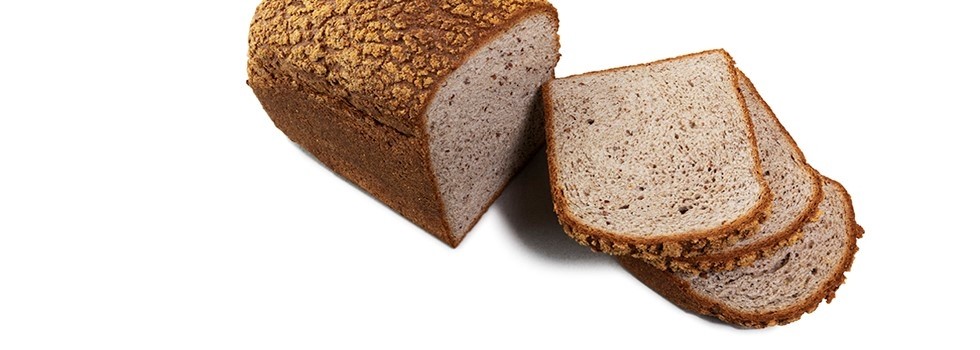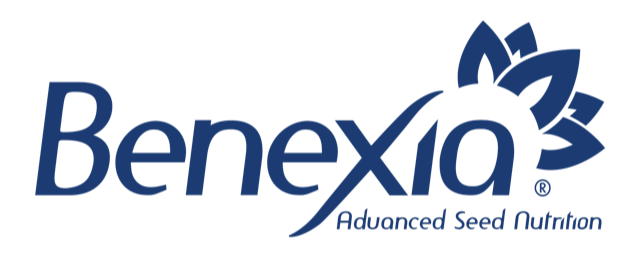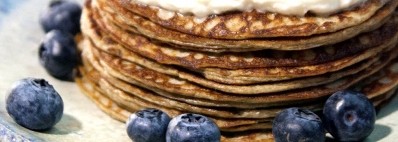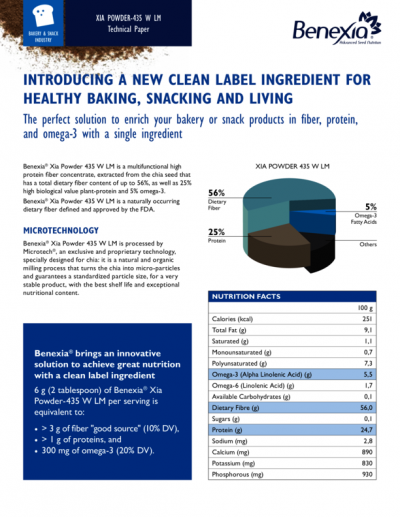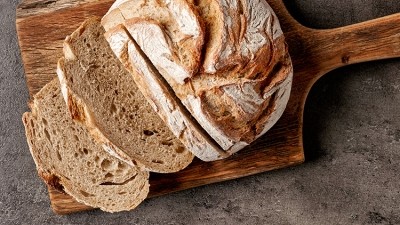Promotional Features
The Latest ‘Natural Fiber’ Bakery Industry Trend: A Close up on Chia Flour
Functional ingredients and trends have changed tremendously for the bakery industry in the last two decades with the latest trends hyper focused on nutritional benefits, ingredient recognition all while maintaining the sensory experience (taste, texture etc). Let’s take a look at the evolution of ingredients in better-for-you bakery products.
EARLY 2000’s: THE DAYS OF ‘LOW FAT’ AND ‘LOW SUGAR’
To meet the need of reducing fat and sugar content in baking products during the early 2000’s, the industry resorted to food additives to maintain texture and product shelf life. As a result, the ingredient list increased exponentially with ingredients that were (and continue to be) mostly unrecognizable to the consumer. This includes oxidants and reductants (ADA, ascorbic acid, L-cystine), emulsifiers (mono-diglycerides, DATAM, lactylates and polysorbates), hydrocolloids (xanthan gum, guar gum, CMC), preservatives (propionic, sorbic, and benzoic acids), leavening agents, enzymes, and sweeteners.
2010’s: THE GRAIN REVOLUTION
By 2010, with the introduction of new ancient grains and seeds in the food industry, products started to hit the shelves that shifted their focus to the perception of better-for-you and all-natural3. We started to see ‘multi-grain’ products that contained up to seven different grains including buckwheat, quinoa, amaranth, chia, flaxseed, and hemp. However, most of these were used as an inclusion in the finished product, and at very small amounts, sometimes less than 1% of the finished product which in truth, does not add much to the nutritional value of the product. Regardless, consumers started to accept the taste, look and feel of whole grains4 in baked goods.
TODAY: LESS IS MORE
Thanks to improved supply chains and better pricing these ancient grains and seeds have been utilized to develop new ingredients such as flour as well as fiber and protein concentrates5 which are easier to apply in today's baking industry. They also offer more nutritional and textural benefits in formulations.
FIBER INGREDIENTS FOR A CLEANER LABEL
Fiber is one ingredient that can be directly incorporated into better-for-you baked goods and take the place of many food additives, making the finished product simpler and cleaner for the consumer.
And speaking of today’s consumers, they are more knowledgeable and informed than ever before and place a greater emphasis on ingredient sourcing and nutritional attributes. It just so happens that some of these fiber ingredients are not only nutritionally superior to most of the flour currently used in the industry but are also appropriate for specific dietary needs including gluten-free, keto, low carb, and high protein.
CHIA FLOUR: HIGH IN FIBER, PROTEIN, OMEGA-3, LOW IN CARBOHYDRATES
One popular, and natural, fiber ingredient is chia flour, a defatted milled chia seed powder. Chia flour is high in fiber (56%), protein (25%), and healthy omega-3 fats (10%) making it an ideal ingredient when looking to boost the nutritional profile of baked products. The fiber found in chia flour, which is a combination of both insoluble and soluble fibers, touts the following:
Improves texture: The insoluble fiber adds body and crumb consistency to the dough formation10,11. The soluble fiber, known as the chia mucilage, has a pseudo-plasticity characteristic similar to food additives such xanthan gum and carboxymethyl cellulose (CMC), which help to increase dough elasticity and help to maintain a flexible spongy crumb texture after baking and throughout the finished product’s shelf life7,11. They are also stable in both high temperature and in frozen baking applications6.
Delivers a ‘whole grain’ sensory experience: in flavor, smell, and color, aligning with consumer expectations10.
Optimizes water absorption capability and yield: Chia flour can absorb up to nine times it’s weight in water thanks to its fiber and protein content12 which can significantly increase final product yield. The fiber holds water in the dough, keeping a low water activity and ensuring a longer shelf life compared to formulations without chia flour. This also helps keep finished product costs down.
CHIA FLOUR: AN EXCEPTIONAL ALL-NATURAL FIBER INGREDIENT
Chia flour is gluten-free, keto friendly, low carb, and high in protein. It’s demonstrated functionality minimizes the need for additives such as eggs, stabilizers, and emulsifiers, allowing for the development of new products with fewer ingredients. The end result? A delicious, clean, nutrient dense, more natural ingredient list aligned with current consumer demands.8,9,10
At Benexia, we are experts in chia. We manufacture numerous all-natural environmentally friendly chia ingredients for food and nutraceutical applications and work closely with R&D facilities to provide our customers with integrated chia ingredient solutions.
-----
References:- Martinez-Saez, N.; Tamargo García, A.; Domínguez Pérez, I.; Rebollo-Hernanz, M.; Mesías, M.; Morales, F.J.; Martín-Cabrejas, M.A.; del Castillo, M.D. Use of spent coffee grounds as food ingredient in bakery products. Food Chem. 2017, 216, 114–122. [CrossRef] [PubMed]
- Duodu, K.G. Effects of processing on antioxidant phenolics of cereal and legume grains. In Advances in Cereal Science: Implications to Food Processing and Health Promotion; Awika, J.M., Piironen, V., Bean, S., Eds.; American Chemical Society: Washington, DC, USA, 2011.
- Abdel-Aal, E.M.; Rabalski, I. Effect of baking on free and bound phenolic acids in wholegrain bakery products. J. Cereal Sci. 2013, 57, 312–318. [CrossRef]
- Purlis, E. Browning development in bakery products—A review. J. Food Eng. 2010, 99, 239–249. [CrossRef]
- Gulsum M. Turkut, Hulya Cakmak, Seher Kumcuoglu, Sebnem Tavman, Effect of quinoa flour on gluten-free bread batter rheology and bread quality, Journal of Cereal Science, Volume 69, 2016, Pages 174-181, ISSN 0733-5210, https://doi.org/10.1016/j.jcs.2016.03.005.
- Kun WANG1, Fei LU 1, Zhe LI1, Lichun ZHAD1, Chunyang HAN,Recent developments in gluten-free bread baking approaches: a review. Food Sci. Technol 37 (Suppl. 1), Dec 2017. https://doi.org/10.1590/1678-457X.01417
- Vázquez-Ovando, A.; Rosado-Rubio, G.; Chel-Guerrero, L.; Betancur-Ancona, D. Physicochemical properties of a fibrous fraction from chia (Salvia hispanica L.). Food Sci. Technol. 2009, 42, 168–173.
- Borneo, R.; Aguirre, A.; León, A.E. Chia (Salvia hispanica L) gel can be used as egg or oil replacer in cake formulations. J. Am. Diet. Assoc. 2010, 110, 946–949. [CrossRef]
- Fernandes, S.S.; de las Mercedes Salas-Mellado, M. Addition of chia seed mucilage for reduction of fat content in bread and cakes. Food Chem. 2017, 227, 237–244. [CrossRef]
- Michele Silveira Coelho*, Myriam de las Mercedes Salas-Mellado, Effects of substituting chia (Salvia hispanica L.) flour or seeds for wheat flour on the quality of the bread, Food Science and Technology 60 (2015) 729e736
- Luciana T. B. Sandri | Fernanda G. Santos | Camilly Fratelli | Vanessa D. Capriles, Development of gluten-free bread formulations containing whole chia flour with acceptable sensory properties. Food Sci Nutr. 2017;5:1021–1028.
- Muñoz, L.A., et al. Chia seeds: Microstructure, mucilage extraction and hydration. Journal of Food Engineering (2011), doi:10.1016/j.jfoodeng.2011.06.037
